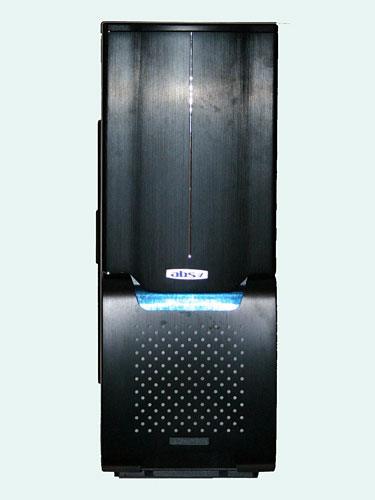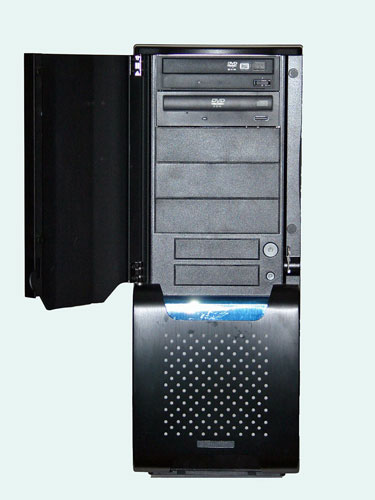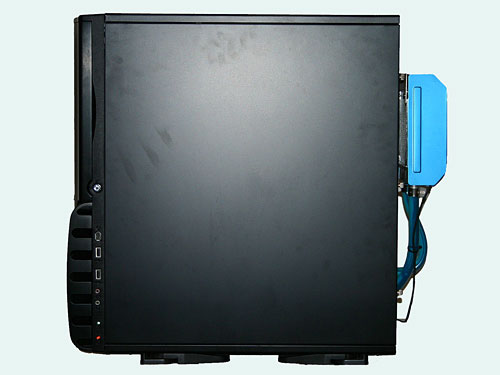ABS Ultimate X9: Core 2 Extreme Hits a Speed Bump
by Jarred Walton on August 18, 2006 1:35 PM EST- Posted in
- Systems
Externals and Appearance
Starting with first impressions, the case certainly appears attractive, though obviously that is a subjective judgment. The all black exterior, dimly glowing blue lights, and relatively quiet operation start things out on a good note. [Sorry for the finger prints -- they showed up in the images due to the flash, though they are not nearly as visible normally.]
ABS uses a Gigabyte Aurora 3D case as the basis of the system. The case is sturdy and is something we would consider purchasing on our own. It's relatively roomy, has a decent layout, and comes equipped with three low-RPM 120mm fans.
The drive bay door is metal and has a very solid feel to it, and it snaps shut with the aid of a reasonably strong magnet. Power and reset buttons as well as the optical drives (and any other external drives) are concealed behind the door, which can be locked with a key if necessary to keep tiny fingers and prying hands away from things they shouldn't touch.
The right side of the case doesn't have much to look at other than the front USB, FireWire, and audio ports. You can also see the lock for the front door, and at the rear of the case you can see the water radiator jutting out. We'll take a closer look at that in a moment.
The view from the left side is similar, with the only difference being the mesh grille towards the rear of the case and the latch used to help secure the side panel. A small amount of light is visible through the ventilation, but it isn't overly bright.
Moving to the rear of the system, we get our first look at the water cooling system. Two ¾" tubes exit from the bottom of the case through an expansion bracket and lead up to the radiator and fan towards the top. At the bottom of the case, where the tubes exit, you can also see the fan speed control for the radiator. Depending on the operating environment and system load, you can reduce noise level quite a bit by turning down the fan speed. With the overclocked CPU and under full stress, however, you will probably want to keep the fan speed at maximum in order to ensure proper cooling.
The features table already covered the various ports that are included, so we won't get into further details of that area. Basically, you get all of the typical connections you would find on the back of any modern computer. In our particular configuration, all of the rear expansion slots are populated, so even if you wanted to there's no available slots to add additional expansion cards. Let's take a look at the inside.
Starting with first impressions, the case certainly appears attractive, though obviously that is a subjective judgment. The all black exterior, dimly glowing blue lights, and relatively quiet operation start things out on a good note. [Sorry for the finger prints -- they showed up in the images due to the flash, though they are not nearly as visible normally.]
 |
| Click to enlarge |
ABS uses a Gigabyte Aurora 3D case as the basis of the system. The case is sturdy and is something we would consider purchasing on our own. It's relatively roomy, has a decent layout, and comes equipped with three low-RPM 120mm fans.
 |
| Click to enlarge |
The drive bay door is metal and has a very solid feel to it, and it snaps shut with the aid of a reasonably strong magnet. Power and reset buttons as well as the optical drives (and any other external drives) are concealed behind the door, which can be locked with a key if necessary to keep tiny fingers and prying hands away from things they shouldn't touch.
 |
| Click to enlarge |
The right side of the case doesn't have much to look at other than the front USB, FireWire, and audio ports. You can also see the lock for the front door, and at the rear of the case you can see the water radiator jutting out. We'll take a closer look at that in a moment.
 |
| Click to enlarge |
The view from the left side is similar, with the only difference being the mesh grille towards the rear of the case and the latch used to help secure the side panel. A small amount of light is visible through the ventilation, but it isn't overly bright.
 |
| Click to enlarge |
Moving to the rear of the system, we get our first look at the water cooling system. Two ¾" tubes exit from the bottom of the case through an expansion bracket and lead up to the radiator and fan towards the top. At the bottom of the case, where the tubes exit, you can also see the fan speed control for the radiator. Depending on the operating environment and system load, you can reduce noise level quite a bit by turning down the fan speed. With the overclocked CPU and under full stress, however, you will probably want to keep the fan speed at maximum in order to ensure proper cooling.
The features table already covered the various ports that are included, so we won't get into further details of that area. Basically, you get all of the typical connections you would find on the back of any modern computer. In our particular configuration, all of the rear expansion slots are populated, so even if you wanted to there's no available slots to add additional expansion cards. Let's take a look at the inside.










48 Comments
View All Comments
JarredWalton - Saturday, August 19, 2006 - link
Don't use the (bracket) H (closebracket) abbreviation in our comments - that's the code for highlight enable, which makes your text white. LOL
JarredWalton - Saturday, August 19, 2006 - link
Multiple uses cause even more troble. :p
JarredWalton - Saturday, August 19, 2006 - link
Have I shut off all text highlights yet? Enquiring minds want to know!
JarredWalton - Friday, August 18, 2006 - link
Take a look at similarly configured Alienware, Falcon NW, VoodooPC, etc. systems and see what they cost. $4500 for the ABS is an absolute bargain by comparison. And don't think that all of those systems are going to be more stable than this ABS. I tried a Quad SLI config for a while that was much, MUCH less stable than this system. The review would have been very unfavorable, but as the company basically pulled the configuration I had there was no reason to "review" a phantom product.Alienware is about $4300 without overclocking or watercooling.
FNW Talon with E6700 and 7950GX2: $6000
FNW Mach V with X6800 watercooling and CrossFire: $8230
VoodooPC Omen CrossFire: $7600
None of those come factory overclocked as far as I can tell, but I'm sure they could be. Still, there's a big difference between $4500 and $6000+. Are they more stable? I don't know - I haven't tested any of the above configurations.
As for ways to improve system reviews, I'm open for suggestions. Simply stating "be like HardOCP" doesn't really help much. What would you like to see added? Compare what this review told you about gaming to what others show, and let me know what's really different about the conclusions. Where do we fall short? I have plenty more system reviews, so if there are specific improvements to be made I'd love to try and make them.
Thanks,
Jarred Walton
Editor
AnandTech.com
yyrkoon - Friday, August 18, 2006 - link
Personally, I find your articles fine the way they are, whihc is why I'll read YOUR articles over Toms any day of the week (because you guys seem to tell it how it is, and how you'd think the company you're reviewing would want to hear it.yyrkoon - Friday, August 18, 2006 - link
err and NOT how you'd think the company you're reviewing would want to hear it (left out 'not'), sorry.MarkHark - Friday, August 18, 2006 - link
Thumbs up for you, Jarred, twice in fact!First for a well-thought, well-written review, second and most important for your last comment.
samuraiBX - Friday, August 18, 2006 - link
now if one of you will please run over me so I can get the money from my insurance... :PJarredWalton - Friday, August 18, 2006 - link
We've got a $1400 system review coming soon, for "the rest" of our readers. :)yyrkoon - Friday, August 18, 2006 - link
Sub 1,000 system review would be much bettter ;) Anyhow, nice clean looking wiring (until you look into the drive bays), additional fan on a water cooled CPU ?! 3000-4000 Price ?!Personally, I would never consider buying a OEM type system, but man even though it has semi clean wiring, neat gadgets like a Air cooling assisted water block, excellent non gaming performance, I would expect said system to be stable, offer the best gaming performance period, and to cook for me . . .